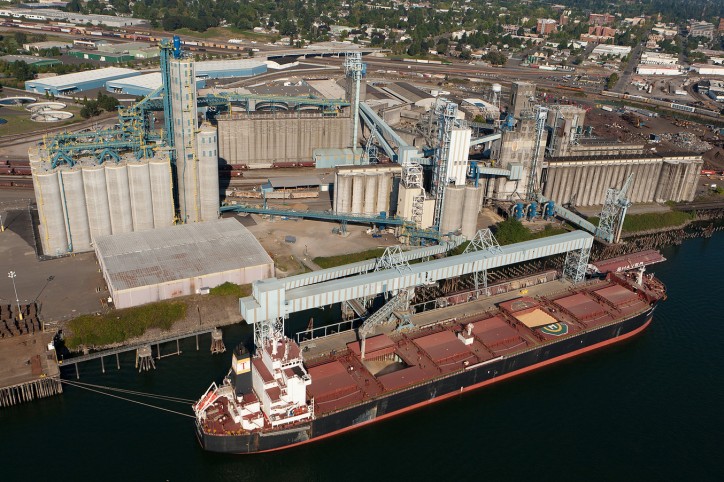The number of ocean-going vessels waiting to be loaded with grain at the Port of Vancouver has increased to 30. It’s the highest number the port has seen in more than a year.
However, that doesn’t necessarily mean Western Canada’s supply chain for grain and oilseeds is functioning poorly, says Mark Hemmes of Quorum Corp., who is in charge of the federal grain monitoring program.
Those kinds of numbers certainly warrant attention, but grain is still flowing well from prairie elevators to port position and export volumes are good, he added.
“We don’t see any reason to panic right now ,” Hemmes said. “The system is still pretty much humming along.”

United Grain's Vancouver Export Terminal - the largest elevator on the West Coast of the United States - Image: UGC
Figures from the grain monitoring program’s Week 32 update show that the lineup of vessels at Vancouver has increased by four.
The current one-year average is 18 vessels, and the port reached a record high of 38 in January 2014, when the western Canadian supply chain for grain and oilseeds was severely congested. Hemmes said 30 vessels is unusually high, which nobody likes to see.
However, most port terminals are still recording good throughput. For example, 15 vessels cleared at Vancouver in Week 33, suggesting efficient throughput despite challenging weather conditions.
Loading efforts at the West Coast have been plagued by incessant rain during much of the past month. Most terminals have systems in place that can allow loading to continue through periods of light rain or unsettled weather. However, loading activities usually are suspended during periods of prolonged steady rainfall, which is common in Vancouver at this time of year.
“When it gets into spring, you often get long shots of rain on the West Coast, and (during the second and third weeks of March) they had maybe two days where they had continuous loading,” Hemmes said. “Otherwise, they had to keep doing the start-stop-start-stop-start-stop because of rain.”
The long-term forecast for the last week of March and the first part of April is more conducive to uninterrupted loading. The cost of ocean freight and demurrage is also likely contributing to the abnormally high vessel numbers.
The Baltic Dry Index hit an all-time low of 317 earlier this year, which indicates record low rates for ocean freight. It peaked at an all-time high of 11,440 in May 2008, when shipping companies were negotiating terms that included high demurrage charges on any vessel that was not loaded within the prescribed time frame.
Today’s record low rates reflect ample supplies of available ships and relatively low demand. The likelihood of negotiating a contract that favour shippers is much greater under those conditions. Demurrage fees are much lower and contract terms are more flexible.
Demurrage costs on a Panamax sized vessel was more than $80,000 a day in 2008, compared with $3,200 a day in late March 2016.
“When you’ve got this much supply, some of the vessels will probably give them (shippers) a little bit more flexibility in the demurrage rates,” Hemmes said.
“Having lower freight rates definitely gives shippers more flexibility in how they manage their resources, but by the same token … no one likes to pay demurrage.”
Source: Producer